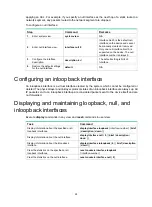
11
Configuring dampening on an Ethernet interface
The interface dampening feature uses an exponential decay mechanism to prevent excessive
interface flapping events from adversely affecting routing protocols and routing tables in the network.
Suppressing interface state change events protects the system resources.
If an interface is not dampened, its state changes are reported. For each state change, the system
also generates an SNMP trap and log message.
After a flapping interface is dampened, it does not report its state changes to the CPU. For state
change events, the interface only generates SNMP trap and log messages.
Parameters
•
Penalty
—The interface has an initial penalty of 0. When the interface flaps, the penalty
increases by 1000 for each down event until the ceiling is reached. It does not increase for up
events. When the interface stops flapping, the penalty decreases by half each time the half-life
timer expires until the penalty drops to the reuse threshold.
•
Ceiling
—The penalty stops increasing when it reaches the ceiling.
•
Suppress-limit
—The accumulated penalty that triggers the device to dampen the interface. In
dampened state, the interface does not report its state changes to the CPU. For state change
events, the interface only generates SNMP traps and log messages.
•
Reuse-limit
—When the accumulated penalty decreases to this reuse threshold, the interface is
not dampened. Interface state changes are reported to the upper layers. For each state change,
the system also generates an SNMP trap and log message.
•
Decay
—The amount of time (in seconds) after which a penalty is decreased.
•
Max-suppress-time
—The maximum amount of time the interface can be dampened. If the
penalty is still higher than the reuse threshold when this timer expires, the penalty stops
increasing for down events. The penalty starts to decrease until it drops below the reuse
threshold.
The ceiling is equal to 2
(Max-suppress-time/Decay)
× reuse-limit. It is not user configurable.
shows the change rule of the penalty value. The lines t
0
and t
2
indicate the start time and
end time of the suppression, respectively. The period from t
0
to t
2
indicates the suppression period, t
0
to t
1
indicates the max-suppress-time, and t
1
to t
2
indicates the complete decay period.
















































